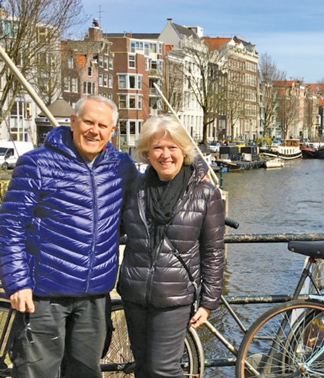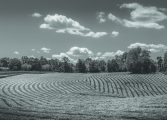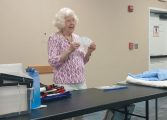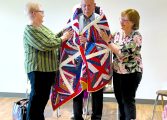By Page H. Gifford, Correspondent
For any artist visiting the home of their favorite artist would be a dream come true. For Susan Lang and her husband Fred, visiting Rembrandt’s home and studio in Amsterdam during her trip to the Netherlands was beyond what she had ever imagined.
They began their travels in Amsterdam, where they stayed five days, then continued down the Rhine on a river cruise. “We could have easily spent another week in Amsterdam and still not cover all there is to see.
“Amsterdam is a busy, energized city with more bicycles than cars. There were so many canals and small bridges everywhere. We stayed in the old city and walked everywhere, and we were able to escape the crowds and find our own little area of the city around the corners,” said Lang. “The people were friendly, and English was spoken most places. Night time was amazing with the buildings and street lights casting reflections across the water. They call it the Venice of the north.” She added that the cuisine was certainly an added bonus.
“The countryside is beautiful and steeped in history. The old windmills show life as it was. But today, the horizons are dotted with new wind turbines, and solar panels are abundant even in the depths of Germany’s Black Forest.”
When one thinks of The Netherlands, wooden shoes and tulips also come to mind along with the windmills. “The Keukenhof Gardens are open to the public with seven million flower bulbs, mostly tulips, planted across seventy-nine acres.” A massive amount of color and for an artist like Lang the tulips in an array of rai nbow colors was a memorable and delightful view.
nbow colors was a memorable and delightful view.
Lang was in her element visiting Rembrandt’s home on their extended visit in Amsterdam.
From the street, the restored three-story canal home, featured attractive wooden shutters that are green when closed and red when opened.
“Rembrandt paid a fortune for the home in 1639, at the height of his fame and lived and worked there for almost 20 years until he went bankrupt about five years before his death. A very detailed and complete auction list of his goods and furnishings was made at that time and because of this, his home, studio and office were able to be recreated for today’s visitors,” said Lang.
“Rembrandt lived on the first floor but etched and painted on the upper floors. You really get a sense of how he lived, including seeing his bedroom up close and personal. I really loved his cabinet of curiosities, a grouping of random artifacts he collected so he could use them in his paintings, including stuffed lizard, shells, horns, coins, busts, bones, tomes, and other objects.”
“Rembrandt was also a much sought after art teacher and tutored over 50 students during his lifetime. He had a teaching studio, which could accommodate around five of them at one time, where they were separated by partitions made of wood, or cloth,” said Lang. “He made his money primarily from his teaching; his own paintings; but he also was an art dealer, which he learned from his mentor.”
She described his studio and where he painted.
“There is an easel in the middle along with a table and a giant flat stone where he would mix paint. We were lucky enough to catch a demonstration of how he would have ground and mixed his pigments.”
Fred, an art lover, enjoyed their visit to The Rijks Museum, the official museum of the Netherlands. This is the location of Rembrandt’s largest painting (12 x14 feet) titled The Night Watch.Within walking distance is the world’s largest collection of works by Dutch painter Vincent van Gogh at the Van Gogh Museum.
The Netherlands as well as most of the Rhineland is steeped in history and was a critical gateway for military strategy during World War II. But its best remembered for the poignant story about a young Jewish girl named Anne Frank.
“A visit to Anne Frank’s house was a thought provoking and humbling experience. It is not often that you see a grown man cry as he left this building,” said Lang. Their journey continued down the 820-mile river, taking them past vineyards, fortresses and castles. Passing through Belgium, where the famous Treaty of Versailles was signed, signifying the end of World War I.Then they passed through Luxembourg, France, Germany and Switzerland, where they purchased an iconic and authentic coo-coo clock with a Swiss mechanism that animated various characters on the clock and played one of two tunes on the hour.
History came alive for Susan Lang and her husband. There were few if any regrets about their trip.
“The only down side I can think of is not enough time to take everything in.”





